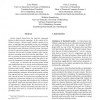Free Online Productivity Tools
i2Speak
i2Symbol
i2OCR
iTex2Img
iWeb2Print
iWeb2Shot
i2Type
iPdf2Split
iPdf2Merge
i2Bopomofo
i2Arabic
i2Style
i2Image
i2PDF
iLatex2Rtf
Sci2ools
SRDS
2006
IEEE
2006
IEEE
Solving Consensus Using Structural Failure Models
Failure models characterise the expected component failures in fault-tolerant computing. In the context of distributed systems, a failure model usually consists of two parts: a functional part specifying in what way individual processing entities may fail and a structural part specifying the potential scope of failures within the system. Such models must be expressive enough to cover all relevant practical situations, but must also be simple enough to allow uncomplicated reasoning about fault-tolerant algorithms. Usually, an increase in expressiveness complicates formal reasoning, but enables more accurate models that allow to improve the assumption coverage and resilience of solutions. In this paper, we introduce the structural failure model class DiDep that allows to specify directed dependent failures, which, for example, occur in the area of intrusion tolerance and security. DiDep is a generalisation of previous classes for undirected dependent failures, namely the general adversa...
Related Content
| Added | 12 Jun 2010 |
| Updated | 12 Jun 2010 |
| Type | Conference |
| Year | 2006 |
| Where | SRDS |
| Authors | Timo Warns, Felix C. Freiling, Wilhelm Hasselbring |
Comments (0)

